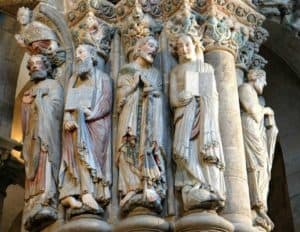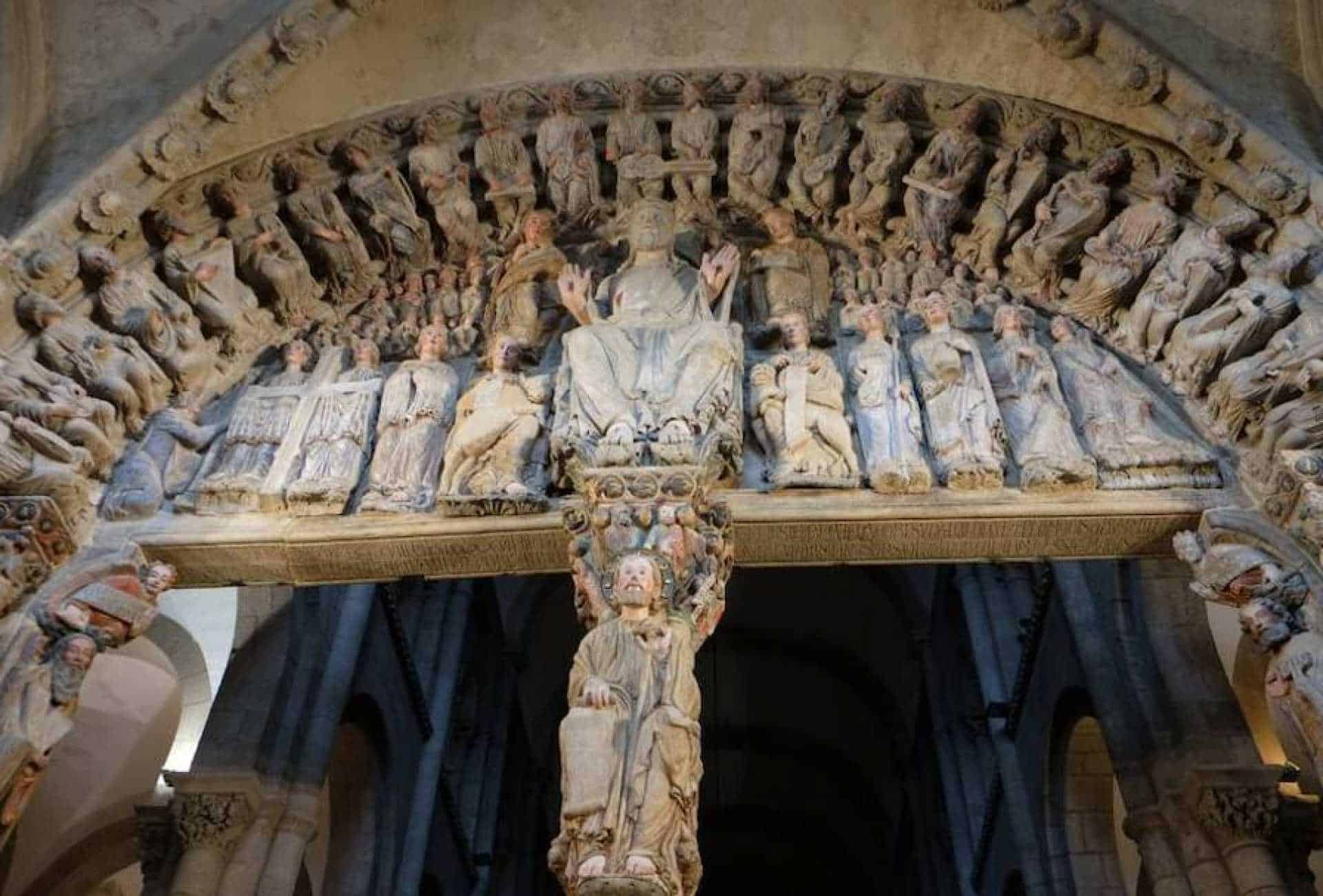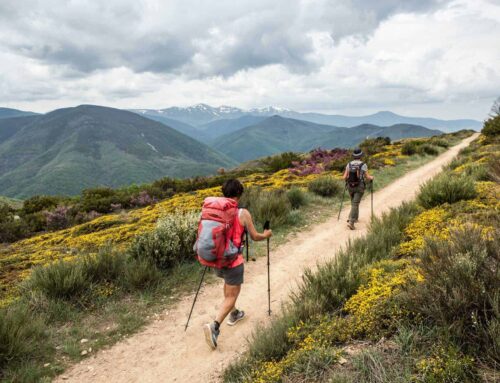The Door of Glory
The Door of Glory, or Portico de la Gloria, is now open to the public after undergoing its own separate restoration project from 2008 until the end of 2018! This means the door has been off limits to any public access for 10 years. Due to the old stones of the Cathedral, the main focus of the works was to prevent further damp and condensation developing in the door. The restoration also recovered the original polychrome of the various colors of the original door. This called for some repainting work, but much of the colours you will see on the door are from the original piece created by the artist, Master Mateo.
History
The Door of Glory dates to 1168 when King Ferdinand II commissioned Master Mateo to finish the remaining works of the Cathedral of Santiago de Compostela. Master Mateo completed other sections of the Cathedral such as the naves and the western closure of the Basilica. However, what was considered his masterpiece is the Portico de la Gloria. He combined the influences of French, Italian and Spanish art to create this magnificent door made of granite and paint. Historians report that this door was one of the marks of the world’s transition to Gothic art.

Door of Glory
The lintel over the Door was placed by Master Mateo on the 1st of April 1188. Inscribed into the Door is a depiction of the Apocalypse which was meant to be presented in a clear and concise way for worshippers who visit the Cathedral.
The Portico shows numerous animals, both real and fictional. Many of these beastly animals represent a symbol for evil. In one arch of the door, there is a representation of Israel abiding by the Mosaic law. In the lower arch the descents of Christ in Limbo are represented. The Final Judgment is depicted in the right arch, with the heads of Christ and Saint Michael.
The actual door is so wide, a column is situated in the middle, supporting the creation. In this column sits the representation of Saint James who is holding a pilgrim’s stick in one hand and a scroll in the other. The scroll contains the words “Misit me Dominus,” translated from Latin, it means -The Lord sent me. On the back side, Master Mateo, himself, is represented at the bottom of the Door of Glory.

Door of Glory
End of the pilgrimage
When pilgrims enter the Cathedral of Santiago de Compostela, there are 4 tasks they were to embark on to complete their pilgrimage.
Task 1
The first task would be to place their hand at the feet of Jesus portrayed on the Door of Glory. Often one would say a prayer here before entering the door.
Task 2
The second task was to then go to the other side of the Door of Glory to the depiction of Master Mateo. They would place their forehead on the bust of Master Mateo, or Santos dos Croques, and tap gently three times. It was thought, that with these bumps, Mateo would pass on his wisdom. Even the local Spaniards believe in the power of Master Mateo. Many of the students from the University of Santiago de Compostela would join in the tradition of rubbing their heads on Master Mateo in hope of becoming the next stellar architect. Some locals would even bring their young children to rub their heads on the door. They believed this act would increase their children’s knowledge and understanding.
Task 3
The third task was to hug the sculpture of St. James at the High Altar in the Cathedral. This was to thank him for the journey and the lessons you learned along the Way. In his hand, he carries a stone that is inscribed with the words:
“Hic Est Corpus Davi Jacobi Apostoli Et Ispaniarum Patroni”
Task 4
The last step of the four rituals was to visit the bones of St. James underneath the High Altar, after all, this is why people began walking to Santiago de Compostela hundreds of years ago.
Pilgrimage tasks you can complete today
Pilgrims have not been able to complete the first two tasks for some time due to deterioration of the Cathedral. Pilgrims and visitors have always been able to view the bones of St. James and hug the replica at the High Altar. However, now pilgrims will have the opportunity to visit the Door. You will not be able touch the door, you will be able to finally see this artwork that has been hidden away for some time.

Door of Glory
Information on Visits
The Portico de la Gloria can be visited by the public. However, to prevent any further deterioration, the number of people is limited at any one time. This is to ensure the door is not impacted by a change in the humidity or temperature. We recommend, if you have the time, to visit the Portico de la Gloria as it really is a masterpiece!
For our fully-supported Camino de Santiago Tours we will do our best to try to ensure a guided tour of the Portico de la Gloria.
For our self-guided tour pilgrims, you can buy tickets at the official Cathedral of Santiago de Compostela website. The maximum of 9 persons is allowed at a time. You can also purchase tickets on the day at the Museum Store in front of the Cathedral. The museum store is located to the right side when you are facing the façade in Praza Obradoiro. All public tours will only be provided in the Spanish language. They do not offer an English tour (at least at the time of writing this article).
Opening Hours
Hours
- Winter hours (November to March). From Monday to Sunday: 10:00 – 20:00.
- Summer hours (April to October). From Monday to Sunday: 09:00 – 20:00.
- Box office and admission to the Museum close one hour earlier.
Duration of the visit
- Approximate duration of the visit: 45 minutes.
Information on ongoing Cathedral Renovation
Due to the ongoing renovations on the Cathedral de Santiago, there will be restricted use of the Cathedral in 2019, carrying through the year 2020. The swarms of pilgrims who have finished the Camino de Santiago over the past six years have entered Praza Obradoiro with the view of the famous Cathedral partially covered. Scaffolding has covered the dramatic spires since 2013 when the Church began a multi-million Euro renovation project.
The entire renovation project, carried out between 2013 and 2018, cost 9.2 million Euros. This work updated the Clock Tower, façade of the Azabacheria, Royal Porch and the towers of the façade facing Praza Obradoiro. This is the plaza where pilgrims finish their Camino de Santiago and rest their tired legs. In late 2018, the Cathedral de Santiago scaffolding came down. For those who have seen the Cathedral since the works were completed on the façade, you can really see the difference and appreciate the work put into restoring this historic building.
Further projects have now begun and the cost is adding a further 15 million Euros to the renovation project. During this time, the Cathedral will see 9 restoration projects requiring scaffolding in other parts of the structure.
Mass and Botafumeiro
Mass will not be held at the Cathedral for the time being. It will be held at two churches in the Old Town of Santiago de Compostela. There will be a 7 P.M. Mass at the Iglesia de Santa Maria Salome, Rua Nova 31. The 12 P.M. Mass will be held at the Iglesia de San Francisco, which is the church connected to the San Francisco Hotel Monumento, Campillo de San Francisco, 3.
The renovations also mean the short- term termination of the Botafumeiro, the incense burner. As of now, the Church has announced the renovations deadline for the entire project is by the next Holy Year in 2021.
Visitor and pilgrims will still be able to visit the Cathedral. They will also be able to partake in the rituals of visiting the bones of St. James and to hug the statue of St. James at the high altar. Although this may be disappointing, we promise you that the Cathedral even during renovations, is a spectacular site at the end of your pilgrimage!







Leave A Comment